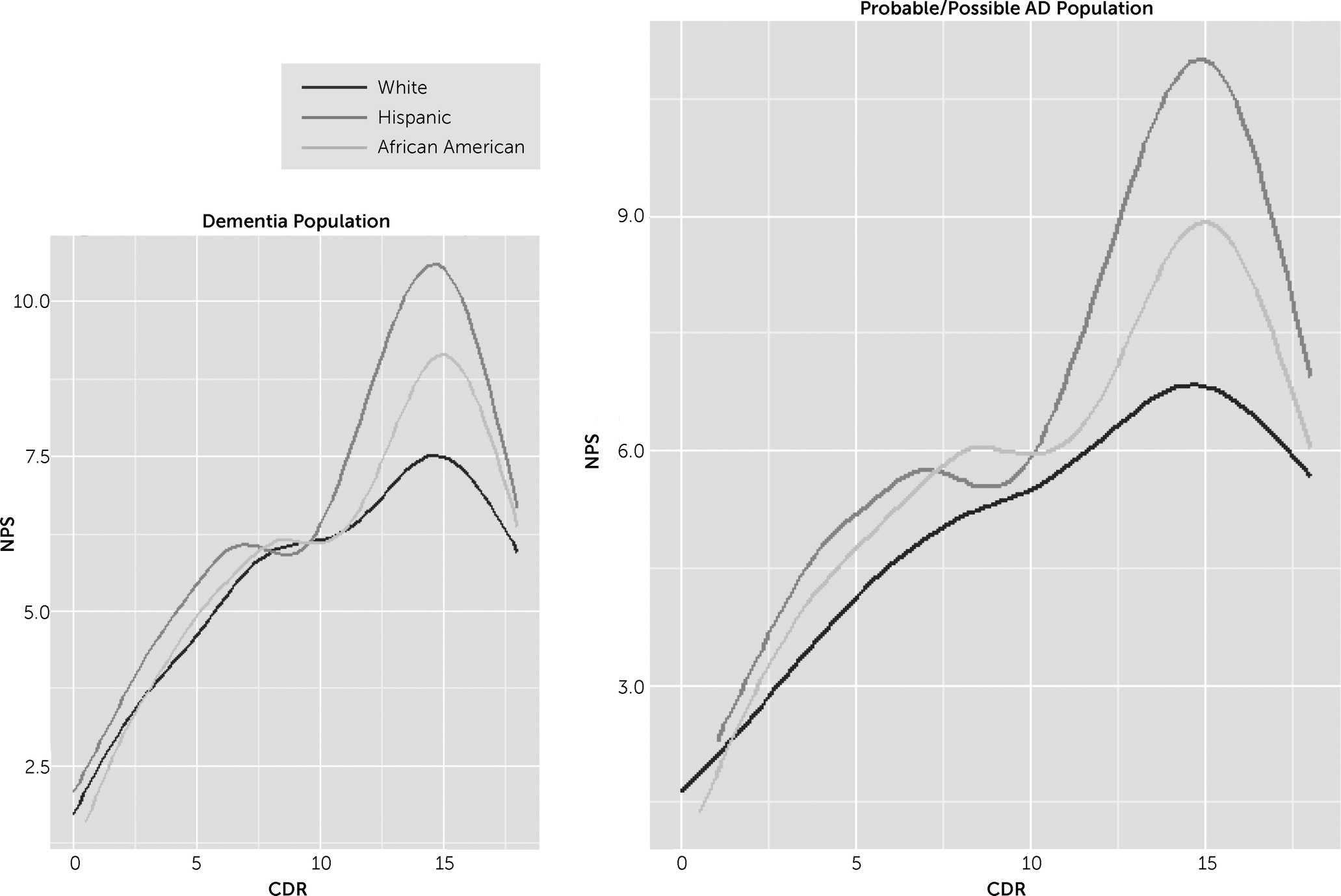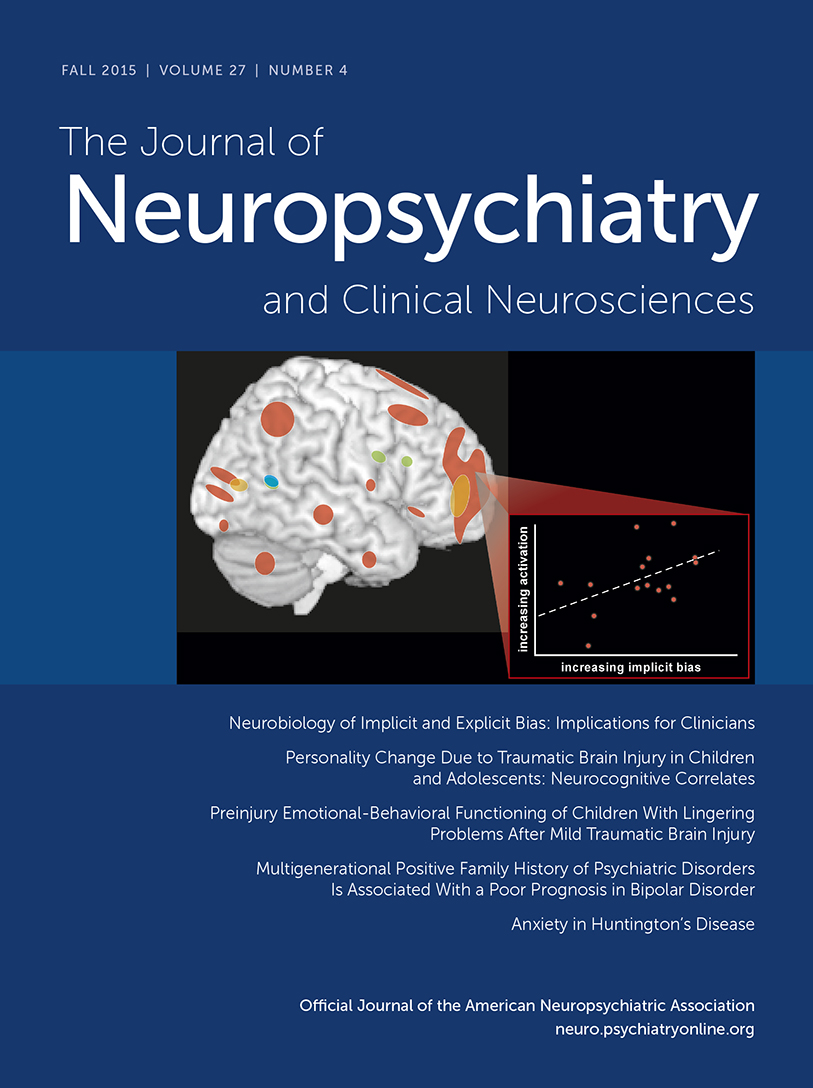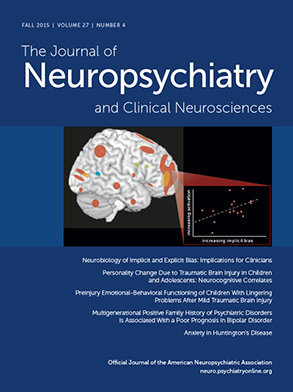Antipsychotic Use in a Diverse Population With Dementia: A Retrospective Review of the National Alzheimer’s Coordinating Center Database
Abstract
Methods
Population and Participants
Study Outcome
Statistical Analysis
Results
| Variable | No Antipsychotic Drug Use (N=7,989) | Antipsychotic Drug Use (N=930) | Percent Taking Antipsychotic Drugs (10.43%) | Univariate Logistic Regression |
|---|---|---|---|---|
| Primary predictor of interest | ||||
| Race/ethnicity | ||||
| White | 6,377 | 710 | 10 | 1.00 |
| Hispanic | 719 | 130 | 15 | 1.62 (1.32–1.98)b |
| African American | 893 | 90 | 9 | 0.9 (0.71–1.13) |
| Key predictors | ||||
| Sociodemographic | ||||
| Age, years | 74±10.5 | 73±11.1 | 0.99 (0.98–1) | |
| <70 | 2,570 | 339 | 12 | 1.23 (1.06–1.43)b |
| 70–75 | 1,522 | 173 | 10 | 1.06 (0.84–1.42) |
| >75 | 3,897 | 418 | 10 | 1.00 |
| Gender | ||||
| M | 3,846 | 473 | 11 | 1.00 |
| F | 4,143 | 457 | 10 | 0.9 (0.78–1.03) |
| Education | 14±3.8 | 14±4.2 | 0.96 (0.95–0.98)b | |
| Less than high school | 952 | 152 | 14 | 1.35 (1.11–1.65)b |
| High school | 3,292 | 388 | 11 | 1.00 |
| College | 1,857 | 186 | 9 | 0.85 (0.71–1.02) |
| Graduate education | 1,888 | 204 | 10 | 0.92 (0.77–1.09) |
| NPS severity | ||||
| Sum of boxes | 5±4.5 | 8±5.9 | 1.12 (1.1–1.13)b | |
| CDR | ||||
| Sum of boxes | 7±4.3 | 12±5.3 | 1.21 (1.19–1.23)b |
Univariate Analysis
Multivariate Analysis
| Variable | Model I | Model II | Model III |
|---|---|---|---|
| Primary predictor of interest | |||
| Race/ethnicity | |||
| Hispanic compared with white | 1.41 (1.11–1.77)b | 1.21 (0.95–1.54) | 1 (0.77–1.29) |
| African American compared with white | 0.88 (0.69–1.12) | 0.8 (0.61–1.01) | 0.79 (0.61–1.01) |
| Key predictors | |||
| Sociodemographic | |||
| Age | |||
| Effect of 1-year increase | 0.99 (0.98–0.99)b | 1.00 (0.98–1) | 0.99 (0.98–0.99)b |
| Gender | |||
| Women compared with men | 0.86 (0.75–0.99)b | 0.9 (0.78–1.04) | 0.79 (0.68–0.92)b |
| Education | |||
| Less than high school compared with high school | 1.26 (1–1.58)b | 1.17 (0.93–1.48) | 1.10 (0.86–1.4) |
| College compared with high school | 0.83 (0.69–1)b | 0.87 (0.72–1.05) | 0.87 (0.71–1.06) |
| Graduate education compared with high school | 0.89 (0.74–1.06) | 0.93 (0.77–1.12) | 0.95 (0.78–1.16) |
| NPS severity | |||
| Sum of boxes | 1.11 (1.1–1.13)b | 1.08 (1.06–1.09)b | |
| CDR | |||
| Sum of boxes | 1.2 (1.18–1.22)b |
| Variable | Model I | Model II | Model III |
|---|---|---|---|
| Primary predictor of interest | |||
| Race/ethnicity | |||
| Hispanic compared with white | 1.74 (1.34–2.27)b | 1.46 (1.11–1.92)b | 1.19 (0.88–1.59) |
| African American compared with white | 0.99 (0.75–1.28) | 0.88 (0.66–1.15) | 0.88 (0.66–1.17) |
| Key predictors | |||
| Sociodemographic | |||
| Age | |||
| Effect of 1-year increase | 1.00 (0.99–1.01) | 1.01 (0.99–1.02) | 1.00 (0.99–1) |
| Gender | |||
| Women compared with men | 0.93 (0.78–1.1) | 0.96 (0.81–1.4) | 0.85 (0.71–1.03) |
| Education | |||
| Less than high school compared with high school | 1.20 (0.92–1.56) | 1.11 (0.85–1.46) | 1.03 (0.77–1.37) |
| College compared with high school | 0.86 (0.68–1.08) | 0.92 (0.72–1.16) | 0.91 (0.71–1.17) |
| Graduate education compared with high school | 0.97 (0.77–1.2) | 1.03 (0.81–1.29) | 1.08 (0.85–1.38) |
| NPS severity | |||
| Sum of boxes | 1.12 (1.1–1.13)b | 1.07 (1.06–1.09)b | |
| CDR | |||
| Sum of boxes | 1.23 (1.21–1.26)b |
| Variable | No Antipsychotic Drug Use (N=6,434) | Antipsychotic Drug Use (N=625) | Percent Taking Antipsychotic Drugs (8.85%) | Univariate Logistic Regression |
|---|---|---|---|---|
| Primary predictor of interest | ||||
| Race/ethnicity | ||||
| White | 4,991 | 439 | 8 | 1.00 |
| Hispanic | 645 | 112 | 15 | 1.97 (1.57–2.46)b |
| African American | 798 | 74 | 8 | 1.05 (0.81–1.36) |
| Key predictors | ||||
| Sociodemographic | ||||
| Age, years | 75±10 | 76±10 | 1.00 (0.99–1.01) | |
| <70 | 1,690 | 150 | 8 | 0.87 (0.71–1.06) |
| 70–75 | 1,204 | 114 | 9 | 0.93 (0.74–1.15) |
| >75 | 3,540 | 361 | 9 | 1.00 |
| Gender | ||||
| M | 2,929 | 285 | 9 | 1.00 |
| F | 3,505 | 340 | 9 | 1.00 (0.85–1.18) |
| Education | 14±3.8 | 14±4.4 | 0.96 (0.94–0.98)b | |
| Less than high school | 837 | 121 | 13 | 1.52 (1.21–1.91)b |
| High school | 2,642 | 251 | 9 | 1.00 |
| College | 1,475 | 119 | 7 | 0.85 (0.67–1.06) |
| Graduate education | 1,480 | 134 | 8 | 0.95 (0.76–1.18) |
| NPS severity | ||||
| Sum of boxes | 4±4.3 | 7±6 | 1.12 (1.1–1.14)b | |
| CDR | ||||
| Sum of boxes | 7±4.2 | 12±5.2 | 1.25 (1.23–1.27)b |

Discussion
References
Information & Authors
Information
Published In
History
Authors
Funding Information
Metrics & Citations
Metrics
Citations
Export Citations
If you have the appropriate software installed, you can download article citation data to the citation manager of your choice. Simply select your manager software from the list below and click Download.
For more information or tips please see 'Downloading to a citation manager' in the Help menu.
View Options
View options
PDF/EPUB
View PDF/EPUBLogin options
Already a subscriber? Access your subscription through your login credentials or your institution for full access to this article.
Personal login Institutional Login Open Athens loginNot a subscriber?
PsychiatryOnline subscription options offer access to the DSM-5-TR® library, books, journals, CME, and patient resources. This all-in-one virtual library provides psychiatrists and mental health professionals with key resources for diagnosis, treatment, research, and professional development.
Need more help? PsychiatryOnline Customer Service may be reached by emailing [email protected] or by calling 800-368-5777 (in the U.S.) or 703-907-7322 (outside the U.S.).

